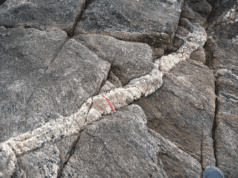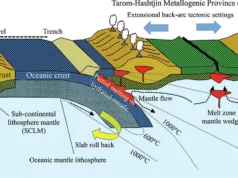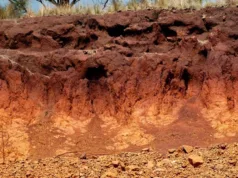Mississippi Valley-Type (MVT) deposits are a specific type of mineral deposit characterized by the occurrence of lead and zinc ores. These deposits are named after the Mississippi Valley region in the United States, where they were first recognized and extensively studied. MVT deposits are part of the broader category of sedimentary exhalative (SEDEX) deposits, which form through the deposition of minerals from hydrothermal fluids that originate in the Earth’s crust.
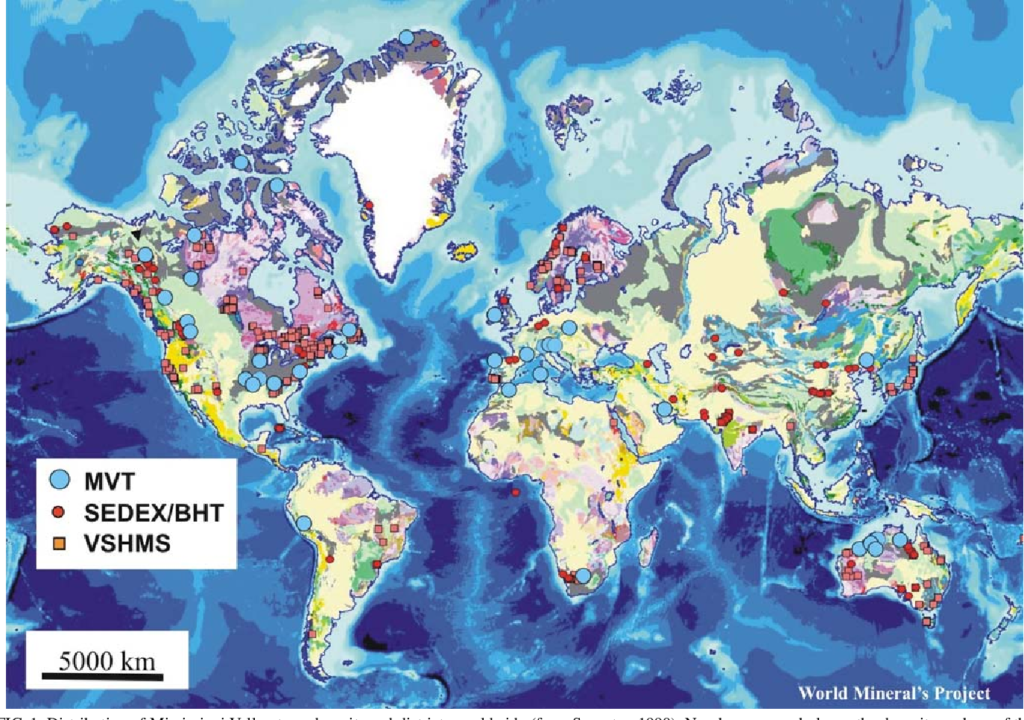
Definition of Mississippi Valley-Type (MVT) Deposits:
MVT deposits are typically composed of galena (lead sulfide) and sphalerite (zinc sulfide), along with varying amounts of other minerals such as fluorite, barite, and calcite. These deposits are sediment-hosted and are found in carbonate rocks, such as limestone and dolomite, where the ore minerals precipitate from metal-bearing fluids. MVT deposits often occur in faulted and fractured zones, and their formation is closely related to tectonic activity.
Historical Context and Discovery:
The discovery of MVT deposits dates back to the 19th century. The first MVT deposit recognized as such was the Old Mines deposit in Missouri, USA, which was discovered in the 1720s. However, it wasn’t until the late 19th and early 20th centuries that the geological community began to understand the distinctive characteristics of MVT deposits.
The term “Mississippi Valley-Type” was coined by the American geologist Erasmus Haworth in the early 20th century. The deposits gained significant attention in the 1920s and 1930s when economic exploitation of these ores became more widespread. Mining operations in the Mississippi Valley region, particularly in states like Missouri and Illinois, contributed significantly to the global production of lead and zinc during this period.
The understanding of MVT deposits has evolved over time, with ongoing research focusing on the geological processes that lead to their formation. The recognition of MVT deposits in other parts of the world, such as Ireland, Australia, and the Middle East, has expanded the significance of these deposits beyond the Mississippi Valley region. They are now recognized as an important source of lead and zinc on a global scale.
In summary, Mississippi Valley-Type deposits represent a specific class of sediment-hosted lead-zinc deposits that were first identified in the Mississippi Valley region in the United States. Their historical context is closely tied to the development of mining operations in this region, and ongoing research continues to enhance our understanding of their geological characteristics and formation processes.
Geological Setting

Mississippi Valley-Type (MVT) deposits are generally found in sedimentary environments and are associated with specific geological conditions. The key factors contributing to the formation of MVT deposits include the presence of suitable host rocks, specific fluid compositions, and favorable structural settings.
Types of Rocks and Formations Associated with MVT Deposits:
- Carbonate Rocks: MVT deposits are commonly hosted in carbonate rocks, particularly limestone and dolomite. These rocks provide the necessary chemical environment for the precipitation of lead and zinc minerals from hydrothermal fluids.
- Evaporites: The presence of evaporite deposits, such as gypsum and anhydrite, is often associated with MVT mineralization. Evaporites can act as seals, trapping the mineralizing fluids and creating localized environments conducive to ore deposition.
- Clastic Sedimentary Rocks: MVT deposits may also occur in clastic sedimentary rocks, especially in areas where these rocks are in proximity to carbonate sequences. The clastic rocks can act as hosts or controls for the mineralizing fluids.
Tectonic Settings and Structural Controls:
- Extensional Tectonic Settings: MVT deposits are often associated with extensional tectonic settings. In these environments, faulting and fracturing create conduits for hydrothermal fluids to migrate from the Earth’s crust to the sedimentary basins, facilitating the deposition of ore minerals.
- Faults and Fractures: Structural controls play a crucial role in the formation of MVT deposits. Faults and fractures provide pathways for hydrothermal fluids to move through the Earth’s crust and interact with the host rocks. The movement along these structures can create voids and open spaces where mineralization occurs.
- Dolomitization: Dolomitization, the replacement of limestone by dolomite, is a common process associated with MVT deposits. This alteration can enhance the permeability of the rock, allowing for the movement of mineralizing fluids.
- Karst Topography: MVT deposits may occur in karst terrain, where dissolution of carbonate rocks creates underground conduits and voids. These karst features can serve as pathways for hydrothermal fluids and contribute to the concentration of ore minerals.
Understanding the geological setting of MVT deposits involves considering the interplay of various factors such as rock types, fluid compositions, and tectonic and structural controls. Ongoing research continues to refine our understanding of the geological conditions that contribute to the formation of these economically significant lead and zinc deposits.
Hydrothermal Processes Contributing to MVT Deposit Formation
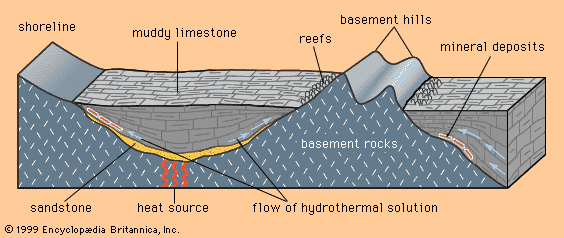
MVT deposits form through hydrothermal processes, where mineral-rich fluids migrate through the Earth’s crust and interact with specific geological environments. The key steps in the formation of MVT deposits include:
- Source of Metals: Metals such as lead and zinc are derived from deep-seated sources within the Earth’s crust. These metals are mobilized into hydrothermal fluids through various geological processes.
- Fluid Migration: Hydrothermal fluids, enriched with metals, migrate through fractures and faults in the Earth’s crust. These fluids are typically brines, which are water solutions containing a high concentration of dissolved salts.
- Interaction with Host Rocks: As the hydrothermal fluids move through the host rocks, they react with minerals in the surrounding environment. In the case of MVT deposits, the host rocks are often carbonate rocks like limestone and dolomite. The interaction leads to the precipitation of ore minerals, including galena (lead sulfide) and sphalerite (zinc sulfide).
- Temperature and Pressure Changes: Changes in temperature and pressure along the fluid migration pathway can trigger the deposition of minerals. As the fluids move towards the Earth’s surface, they encounter conditions where the solubility of certain minerals decreases, leading to their precipitation.
Role of Brines and Fluid Migration:
- Brine Composition: The hydrothermal fluids associated with MVT deposits are typically brines, which are saline solutions. These brines play a crucial role in transporting metal ions from the source rocks to the deposition sites within the sedimentary basin.
- Fluid Migration Pathways: Faults and fractures in the Earth’s crust provide conduits for the migration of hydrothermal fluids. The movement of these fluids is often influenced by tectonic activity, and they follow paths of least resistance, guided by geological structures.
- Fluid-Rock Interaction: As brines migrate through the host rocks, they interact with minerals in the surrounding environment. The dissolution and reprecipitation of minerals along the fluid pathway contribute to the formation of ore deposits.
- Evaporation and Mixing: Changes in the chemical composition of the hydrothermal fluids, such as through evaporation or mixing with other fluids, can trigger the precipitation of minerals. This is often observed in the association of MVT deposits with evaporite minerals.
Mineralization Mechanisms:
- Replacement: The most common mineralization mechanism in MVT deposits is replacement. Hydrothermal fluids replace the original minerals in the host rocks with ore minerals like galena and sphalerite. This replacement process can occur through selective dissolution and reprecipitation.
- Open Space Filling: In areas of increased permeability, such as along faults and fractures, open spaces are created. Hydrothermal fluids can fill these open spaces, forming vein-like deposits of ore minerals.
- Karst-Related Processes: In some MVT deposits, especially those in carbonate rocks, karst-related processes may contribute to mineralization. Dissolution of carbonate minerals creates voids and conduits where ore minerals can accumulate.
Understanding the interplay of these hydrothermal processes, the role of brines, and the specific geological conditions is crucial for deciphering the formation mechanisms of MVT deposits. Ongoing research in economic geology continues to refine our understanding of these processes and enhance exploration strategies for these valuable mineral resources.
Mineralogy and Ore Minerals
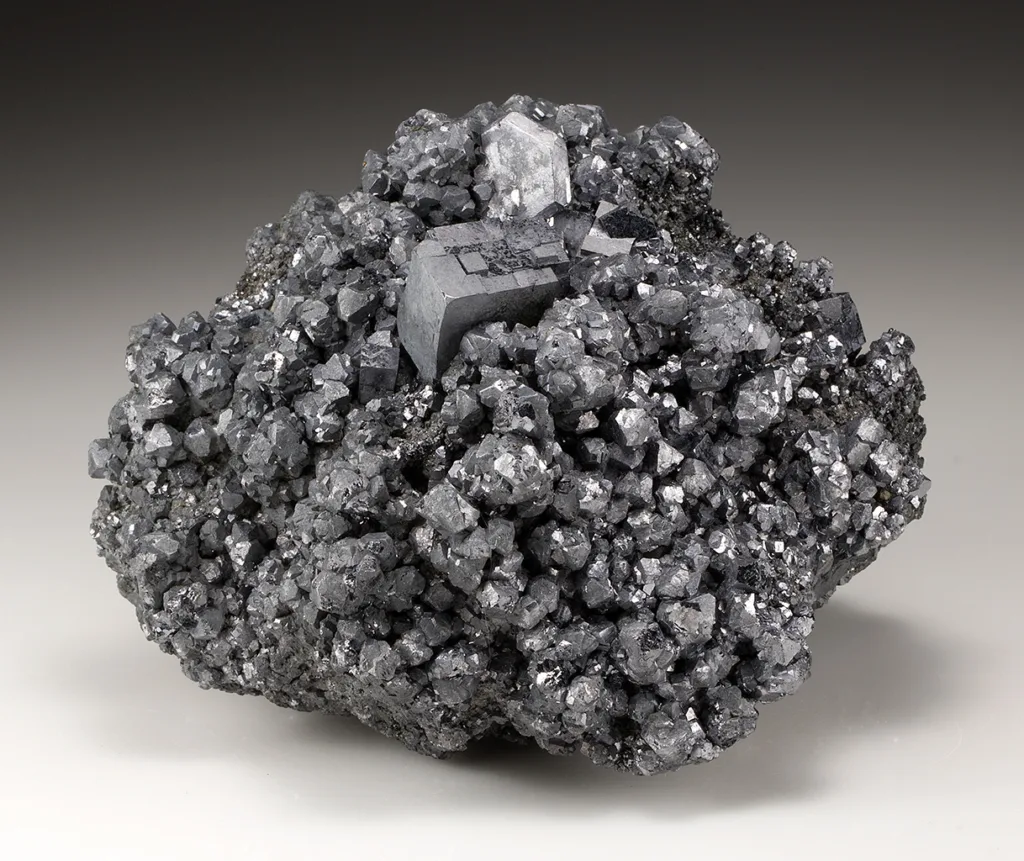
Common Minerals Found in MVT Deposits:
- Galena (Lead Sulfide – PbS): Galena is a primary ore mineral for lead and is commonly found in MVT deposits. It forms cubic or octahedral crystals and has a metallic luster.
- Sphalerite (Zinc Sulfide – ZnS): Sphalerite is the primary ore mineral for zinc in MVT deposits. It often occurs alongside galena and can exhibit a range of colors, including yellow, brown, black, or red.
- Fluorite (Calcium Fluoride – CaF2): Fluorite is a common gangue mineral in MVT deposits, and its presence is often associated with mineralization. It forms cubic crystals and can vary in color, including purple, green, blue, and yellow.
- Barite (Barium Sulfate – BaSO4): Barite is another common gangue mineral in MVT deposits. It typically forms tabular crystals and is often found associated with lead and zinc ores.
- Calcite (Calcium Carbonate – CaCO3): Calcite is a carbonate mineral that may be present in MVT deposits. It can occur as transparent to opaque crystals and is commonly associated with the host carbonate rocks.
- Dolomite (Calcium Magnesium Carbonate – CaMg(CO3)2): Dolomite is often associated with MVT deposits, and its presence may indicate a favorable geological environment for mineralization.
Characteristics and Composition of Ore Minerals:
- Galena (Lead Sulfide – PbS): Galena is a heavy, metallic mineral with a high lead content. It has a distinctive silvery-gray color and is relatively soft.
- Sphalerite (Zinc Sulfide – ZnS): Sphalerite can exhibit various colors and may range from transparent to opaque. It is relatively hard and has a resinous to adamantine luster.
- Fluorite (Calcium Fluoride – CaF2): Fluorite is known for its fluorescence under ultraviolet light. It has a vitreous luster and is relatively soft.
- Barite (Barium Sulfate – BaSO4): Barite is a dense mineral with a high specific gravity. It is typically colorless or white but can also be found in shades of blue, green, or yellow.
- Calcite (Calcium Carbonate – CaCO3): Calcite is transparent to translucent and often exhibits a rhombohedral crystal habit. It effervesces in dilute acid due to its carbonate composition.
- Dolomite (Calcium Magnesium Carbonate – CaMg(CO3)2): Dolomite is similar in appearance to calcite but is distinguished by its characteristic rhombohedral cleavage and its effervescence only in hot or concentrated acid.
Variations in Mineralogy Based on Geological Conditions:
The mineralogy of MVT deposits can vary based on geological conditions such as the composition of the host rocks, fluid chemistry, and temperature. Some variations include:
- Variations in Gangue Minerals: The presence and abundance of gangue minerals, such as fluorite and barite, can vary. These minerals are influenced by the composition of hydrothermal fluids and the local geological environment.
- Evaporite Minerals: In some MVT deposits, the association with evaporite minerals like gypsum and anhydrite can vary, depending on the local hydrothermal conditions and the presence of evaporite sequences.
- Trace Elements: MVT deposits may contain trace elements in addition to lead and zinc. The presence of elements like silver, copper, and cadmium can vary, impacting the economic value of the deposit.
- Metamorphism and Alteration: The degree of metamorphism and alteration in the host rocks can influence the mineralogy of MVT deposits. For example, dolomitization may occur as a result of alteration processes.
Understanding these variations is essential for mineral exploration and exploitation, as they can provide insights into the geological history and conditions that led to the formation of specific MVT deposits. Detailed mineralogical studies contribute to refining models of ore genesis and improving exploration strategies.
Exploration Techniques for MVT Deposits
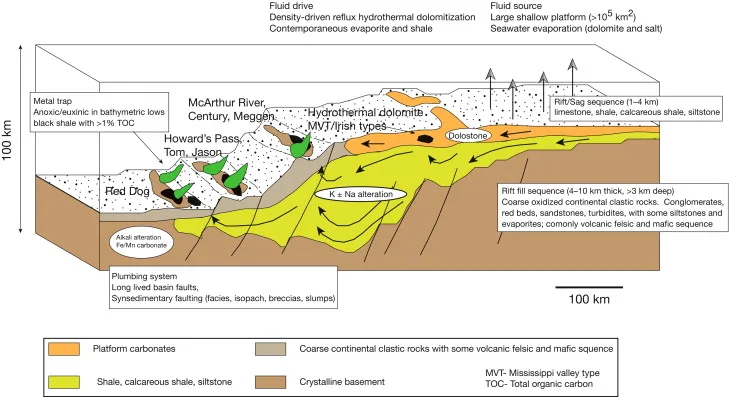
Exploring for Mississippi Valley-Type (MVT) deposits involves a combination of geophysical, geochemical, and remote sensing techniques. These methods help identify potential areas for further exploration and provide valuable information about the subsurface geology. Here are some commonly used exploration techniques:
- Geophysical Methods:
- Gravity Surveys: Gravity anomalies may indicate variations in rock density, helping identify structures and potential ore bodies associated with MVT deposits.
- Magnetic Surveys: Magnetic surveys can detect magnetic anomalies associated with certain minerals, providing insights into the geological structures that may host MVT mineralization.
- Electromagnetic (EM) Surveys: EM surveys can be useful in detecting conductive bodies, including sulfide minerals associated with MVT deposits. Time-domain and frequency-domain EM methods are commonly employed.
- Seismic Surveys: Seismic methods can help image subsurface structures and identify fault zones and other geological features that may be conducive to MVT mineralization.
- Geochemical Approaches:
- Soil Sampling: Geochemical analysis of soil samples can help identify anomalies in metal concentrations, providing clues to the presence of underlying ore bodies.
- Stream Sediment Sampling: Collecting sediment samples from streams can help identify anomalous metal concentrations and guide exploration efforts.
- Rock Sampling: Sampling rocks in the exploration area and analyzing their geochemistry can help identify alterations associated with MVT mineralization.
- Drilling and Core Analysis: Diamond drilling provides direct samples of the subsurface geology, allowing for detailed analysis of ore minerals, alteration zones, and the overall geological context.
- Remote Sensing and Modern Technologies:
- Satellite Imagery: Remote sensing using satellite imagery can be valuable in mapping surface geology, identifying alteration patterns, and delineating geological structures associated with MVT deposits.
- LiDAR (Light Detection and Ranging): LiDAR technology provides high-resolution topographic data, aiding in the identification of subtle geological features and structural patterns.
- GIS (Geographic Information System): GIS integrates various data layers, such as geological maps, geophysical surveys, and geochemical data, facilitating the analysis of spatial relationships and the identification of prospective areas.
- Machine Learning and Data Analytics: Advanced analytical techniques, including machine learning algorithms, can be applied to large datasets to identify patterns and anomalies, helping prioritize exploration targets.
- Drone Technology: Unmanned aerial vehicles (UAVs) equipped with various sensors can provide high-resolution imagery and data for detailed mapping and exploration in areas with limited accessibility.
- 3D Geological Modeling: Creating three-dimensional models of the subsurface geology using modern modeling software helps visualize the distribution of ore bodies and geological structures.
Successful exploration for MVT deposits often involves an integrated approach, combining the strengths of various techniques to generate a comprehensive understanding of the geological setting. Advances in technology and data analysis continue to enhance the efficiency and accuracy of mineral exploration processes.
Case Studies
Notable Examples of MVT Deposits Worldwide:
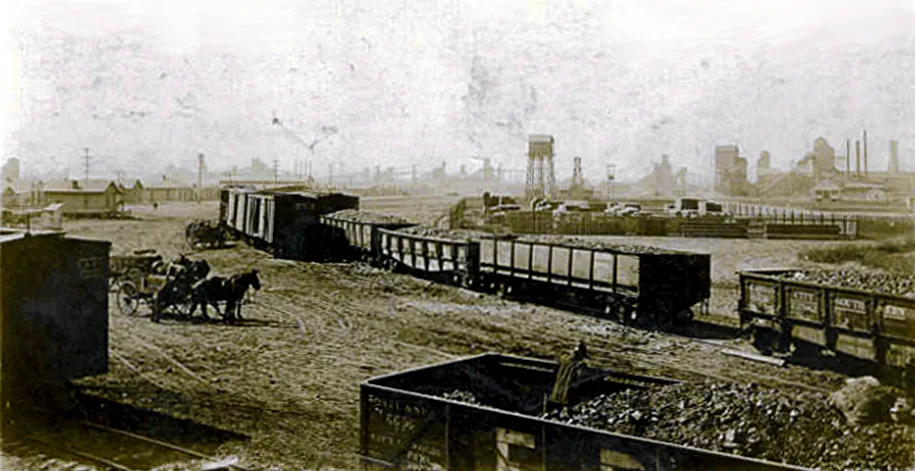
- Tri-State Mining District, USA:
- Location: Missouri, Kansas, and Oklahoma, USA.
- Details: The Tri-State Mining District is one of the most famous MVT districts, historically significant for lead and zinc production. The region, especially Missouri, has numerous MVT deposits, including the Old Lead Belt and the Viburnum Trend.
- Irish Midlands, Ireland:
- Location: Midlands region of Ireland.
- Details: The Irish Midlands host several MVT deposits, including the famous Navan deposit. The Navan deposit is one of the largest zinc-lead deposits in Europe and has been a significant source of base metals for several decades.
- Pine Point, Canada:
- Location: Northwest Territories, Canada.
- Details: The Pine Point Mining Camp in Canada is known for its MVT deposits, primarily zinc-lead ores. The area has been the site of extensive exploration and mining activities, contributing to Canada’s base metal production.
- Dolomitization-Related MVT Deposits, Australia:
- Location: Various regions in Australia.
- Details: Australia has several MVT deposits associated with dolomitization processes. Notable examples include deposits in the McArthur Basin in the Northern Territory and the Admiral Bay and Teena deposits in Western Australia.
- Middle East:
- Location: Various countries in the Middle East.
- Details: MVT deposits are found in several Middle Eastern countries, including Saudi Arabia and Iran. These deposits contribute to the regional production of lead and zinc.
Geographical Distribution and Regional Variations:
The distribution of MVT deposits is not limited to specific continents or regions, but they tend to occur in sedimentary basins with suitable geological conditions. Some general observations include:
- North America: The USA, particularly the Mississippi Valley region, has a well-documented history of MVT deposits. Canada also hosts MVT deposits, including those in the Prairie Provinces and Northwest Territories.
- Europe: Ireland is notable for its MVT deposits, with the Navan deposit being a significant example. Other European countries, such as Poland and Spain, also have MVT occurrences.
- Australia: MVT deposits are found in various regions across Australia, with a particular emphasis on dolomitization-related deposits.
- Asia: Some MVT deposits have been identified in parts of Asia, including the Middle East. Iran and Saudi Arabia are among the countries with known MVT occurrences.
- Africa: While MVT deposits are not as extensively documented in Africa, there are reports of occurrences in different countries, reflecting the potential for these deposits in diverse geological settings.
The distribution of MVT deposits is influenced by geological factors such as the presence of suitable host rocks, tectonic settings, and hydrothermal fluid sources. Exploration efforts in different regions continue to uncover new occurrences and contribute to our understanding of the global distribution of MVT deposits.
Economic Significance
Mississippi Valley-Type (MVT) deposits are economically significant for several reasons, and their exploitation has played a crucial role in the global production of lead and zinc. Here are key aspects of the economic significance of MVT deposits:
- Lead and Zinc Production:
- Primary Sources: MVT deposits are major sources of lead (from galena – lead sulfide) and zinc (from sphalerite – zinc sulfide). These metals are essential for various industrial applications, including batteries, construction materials, and galvanization.
- Contribution to Global Metal Supply:
- Historical Significance: Many MVT deposits have a long history of mining and have been integral to the global metal supply. Regions like the Mississippi Valley in the United States and the Irish Midlands have historically been significant contributors to lead and zinc production.
- Economic Impact on Local and Regional Economies:
- Job Creation: The mining and processing of MVT deposits contribute to job creation in local communities. This includes employment in mining operations, processing plants, and associated support industries.
- Infrastructure Development:
- Infrastructure Investments: The development and operation of MVT mining projects often necessitate significant infrastructure investments. This includes transportation networks, power supply, and other facilities, contributing to regional development.
- Export and Revenue Generation:
- Export of Metals: Lead and zinc extracted from MVT deposits are typically exported to meet global demand. This contributes to the generation of foreign exchange and government revenue.
- Diversification of Economies:
- Diversification in Resource-Dependent Regions: Regions with MVT deposits often experience economic diversification as mining activities contribute to a mix of economic sectors beyond traditional agriculture or other resource-dependent industries.
- Technological Advancements and Innovation:
- Technological Innovation: The exploration and extraction of metals from MVT deposits drive technological innovation in mining and processing techniques. This can lead to advancements that have broader applications in the mining industry.
- Global Market Dynamics:
- Supply and Demand Influences: MVT deposits, as significant sources of lead and zinc, contribute to global market dynamics for these metals. Fluctuations in supply from MVT deposits can impact market prices.
- Environmental and Social Considerations:
- Environmental Practices: Responsible mining practices in MVT deposit operations are increasingly important, with companies adopting environmentally sustainable practices to minimize the impact on ecosystems and communities.
- Long-Term Resource Sustainability:
- Exploration and Resource Planning: Continued exploration for MVT deposits and responsible resource management contribute to the long-term sustainability of lead and zinc resources, ensuring a stable supply for future generations.
In summary, MVT deposits are economically significant due to their role as major sources of lead and zinc, their historical contributions to metal production, and the broader economic impacts on local and regional economies. As with any mineral extraction activity, balancing economic benefits with environmental and social considerations is essential for sustainable development.


























